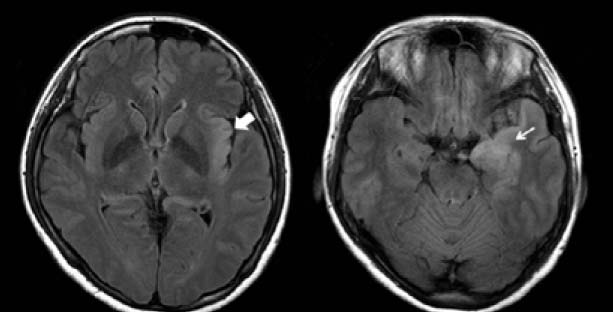Infect Chemother.
2011 Apr;43(2):222-224. 10.3947/ic.2011.43.2.222.
Encephalitis by Co-infection with A/H1N1 Influenza and Herpes Simplex Virus in an Adult Patient
- Affiliations
-
- 1Division of Infectious Diseases, Department of Internal Medicine, Samsung Medical Center, Sungkyunkwan University School of Medicine, Seoul, Korea. cikang@skku.edu
- 2Department of Pediatrics, Samsung Medical Center, Sungkyunkwan University School of Medicine, Seoul, Korea.
- KMID: 1782367
- DOI: http://doi.org/10.3947/ic.2011.43.2.222
Abstract
- Influenza-associated encephalopathy is rare in adults and the role of influenza virus in the pathogenesis of influenza-associated encephalopathy is unclear. We report a case of an adult patient who presented with typical clinical manifestations and magnetic resonance imaging findings of herpes simplex virus (HSV) encephalitis confirmed by positive PCR test in cerebrospinal fluid (CSF), and who was also PCR-positive PCR for H1N1 A/influenza in CSF and a nasopharyngeal swab. The results strongly suggest co-infection of the central nervous system. Given the significant implications for therapeutic interventions and infection control, A/H1N1 influenza should be considered one of the possible etiologies of viral encephalitis when patients present with an influenza-like illness during an influenza epidemic, even in those with typical manifestation of HSV encephalitis.
Keyword
MeSH Terms
Figure
Reference
-
1. Centers for Disease Control and Prevention (CDC). Neurologic complications associated with novel influenza A (H1N1) virus infection in children - Dallas, Texas, May 2009. MMWR Morb Mortal Wkly Rep. 2009. 58:773–778.2. Morishima T, Togashi T, Yokota S, Okuno Y, Miyazaki C, Tashiro M, Okabe N. Collaborative Study Group on Influenza-Associated Encephalopathy in Japan. Encephalitis and encephalopathy associated with an influenza epidemic in Japan. Clin Infect Dis. 2002. 35:512–517.
Article3. Sugaya N, Yoshikawa T, Miura M, Ishizuka T, Kawakami C, Asano Y. Influenza encephalopathy associated with infection with human herpesvirus 6 and/or human herpesvirus 7. Clin Infect Dis. 2002. 34:461–466.
Article4. Studahl M, Bergström T, Hagberg L. Acute viral encephalitis in adults--a prospective study. Scand J Infect Dis. 1998. 30:215–220.
Article5. Kasai T, Togashi T, Morishima T. Encephalopathy associated with influenza epidemics. Lancet. 2000. 355:1558–1559.
Article6. Chen YC, Lo CP, Chang TP. Novel influenza A (H1N1)-associated encephalopathy/encephalitis with severe neurological sequelae and unique image features--a case report. J Neurol Sci. 2010. 298:110–113.
Article7. Choi SY, Jang SH, Kim JO, Ihm CH, Lee MS, Yoon SJ. Novel swine-origin influenza A (H1N1) viral encephalitis. Yonsei Med J. 2010. 51:291–292.
Article8. Gadoth A, Aizenstein O, Mosek A. Influenza a/h1n1 encephalitis. Neurology. 2010. 75:666–667.
Article9. Gonzalez BE, Brust DG. Novel influenza A (H1N1) presenting as an acute febrile encephalopathy in a mother and daughter. Clin Infect Dis. 2009. 49:1966–1967.
Article10. Kitcharoen S, Pattapongsin M, Sawanyawisuth K, Angela V, Tiamkao S. Neurologic manifestations of pandemic (H1N1) 2009 virus infection. Emerg Infect Dis. 2010. 16:569–570.
Article11. Lee N, Wong CK, Chan PK, Lindegardh N, White NJ, Hayden FG, Wong EH, Wong KS, Cockram CS, Sung JJ, Hui DS. Acute encephalopathy associated with influenza A infection in adults. Emerg Infect Dis. 2010. 16:139–142.
Article12. Yi H, Lee JY, Hong EH, Kim MS, Kwon D, Choi JH, Choi WY, Kim KS, Lee JK, Oh HB, Kang C. Oseltamivir-resistant pandemic (H1N1) 2009 virus, South Korea. Emerg Infect Dis. 2010. 16:1938–1942.
Article13. Munakata M, Kato R, Yokoyama H, Haginoya K, Tanaka Y, Kayaba J, Kato T, Takayanagi R, Endo H, Hasegawa R, Ejima Y, Hoshi K, Iinuma K. Combined therapy with hypothermia and anticytokine agents in influenza A encephalopathy. Brain Dev. 2000. 22:373–377.
Article
- Full Text Links
- Actions
-
Cited
- CITED
-
- Close
- Share
- Similar articles
-
- Novel Swine-Origin Influenza A (H1N1) Viral Encephalitis
- A Case of Herpes Simplex Virus Induced Focal Brainstem Encephalitis: A Case Report
- A Case of Maternal Herpes Simplex Virus Type 2 Encephalitis without Genital Skin Lesion
- Relapsing Herpes Simplex Encephalitis Resulting in Kluver-Bucy Syndrome
- A Case of Disseminated Herpes Simplex Virus Infection in Immunocompromised Patient


